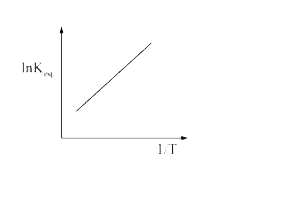log KpKc+log RT=0 is a relationship for the reaction :
(A) PCI5⇔PCI3+CI2
(B) 2SO2+O2⇔2SO3
(C) H2+12⇔2HI
(D) N2+3H2⇔2NH3
The correct Answer is:B
To solve the question regarding the relationship logKpKc+logRT=0, we can follow these steps:
Step 1: Rewrite the given equation
Starting with the equation:
logKpKc+logRT=0
We can combine the logarithms using the property loga+logb=log(ab):
log(KpKc⋅RT)=0
Step 2: Exponentiate both sides
To eliminate the logarithm, we exponentiate both sides:
KpKc⋅RT=100
Since 100=1, we have:
KpKc⋅RT=1
Step 3: Rearrange the equation
Rearranging gives us:
Kp=Kc⋅RT
Step 4: Relate to the change in moles
The relationship Kp=Kc(RT)Δn can be compared to our derived equation. Here, Δn is defined as the change in the number of moles of gas, calculated as:
Δn=(moles of gaseous products)−(moles of gaseous reactants)
From our equation Kp=Kc⋅RT, we can see that Δn=0 because:
Kp=Kc(RT)0⟹Δn=0
Step 5: Identify the reaction
We need to find a reaction where the change in moles of gas (Δn) is equal to 0.
Step 6: Evaluate the options
We will evaluate the given reactions to find one that has Δn=0:
1. Option A: PCl3+Cl2→PCl5
- Reactants: 2 moles (1 PCl3 + 1 Cl2)
- Products: 1 mole (1 PCl5)
- Δn=1−2=−1
2. Option B: N2+3H2→2NH3
- Reactants: 4 moles (1 N2 + 3 H2)
- Products: 2 moles (2 NH3)
- Δn=2−4=−2
3. Option C: 2CO+O2→2CO2
- Reactants: 3 moles (2 CO + 1 O2)
- Products: 2 moles (2 CO2)
- Δn=2−3=−1
4. Option D: H2+I2→2HI
- Reactants: 2 moles (1 H2 + 1 I2)
- Products: 2 moles (2 HI)
- Δn=2−2=0
Conclusion
The reaction that validates the relationship logKpKc+logRT=0 is:
H2+I2→2HI
Starting with the equation:
logKpKc+logRT=0
We can combine the logarithms using the property loga+logb=log(ab):
log(KpKc⋅RT)=0
To eliminate the logarithm, we exponentiate both sides:
KpKc⋅RT=100
Since 100=1, we have:
KpKc⋅RT=1
Rearranging gives us:
Kp=Kc⋅RT
The relationship Kp=Kc(RT)Δn can be compared to our derived equation. Here, Δn is defined as the change in the number of moles of gas, calculated as:
Δn=(moles of gaseous products)−(moles of gaseous reactants)
From our equation Kp=Kc⋅RT, we can see that Δn=0 because:
Kp=Kc(RT)0⟹Δn=0
We need to find a reaction where the change in moles of gas (Δn) is equal to 0.
We will evaluate the given reactions to find one that has Δn=0:
1. Option A: PCl3+Cl2→PCl5
- Reactants: 2 moles (1 PCl3 + 1 Cl2)
- Products: 1 mole (1 PCl5)
- Δn=1−2=−1
- Reactants: 4 moles (1 N2 + 3 H2)
- Products: 2 moles (2 NH3)
- Δn=2−4=−2
- Reactants: 3 moles (2 CO + 1 O2)
- Products: 2 moles (2 CO2)
- Δn=2−3=−1
- Reactants: 2 moles (1 H2 + 1 I2)
- Products: 2 moles (2 HI)
- Δn=2−2=0
The reaction that validates the relationship logKpKc+logRT=0 is:
H2+I2→2HI
Topper's Solved these Questions
- CHEMICAL EQUILIBRIUMBook:RESONANCE ENGLISHChapter:CHEMICAL EQUILIBRIUMExercise:Exercise-2 (Part-1)
Explore 28 Videos
- CHEMICAL EQUILIBRIUMBook:RESONANCE ENGLISHChapter:CHEMICAL EQUILIBRIUMExercise:Exercise-2 (Part-2)
Explore 22 Videos
- CHEMICAL EQUILIBRIUMBook:RESONANCE ENGLISHChapter:CHEMICAL EQUILIBRIUMExercise:Exercise-1 (Part-1)
Explore 38 Videos
- CHEMICAL BONDINGBook:RESONANCE ENGLISHChapter:CHEMICAL BONDINGExercise:ORGANIC CHEMISTRY(Fundamental Concept )
Explore 6 Videos
- D & F-BLOCK ELEMENTS & THEIR IMPORTANT COMPOUNDS Book:RESONANCE ENGLISHChapter:D & F-BLOCK ELEMENTS & THEIR IMPORTANT COMPOUNDS Exercise:Match the column
Explore 1 Video
Similar Questions
What is the relationship between KpandKc ?
View SolutionFor a reaction, aA+bB⇔cC+dD, the reaction quotient Q=[C]c0[D]d0[A]a0[B]b0, where [A]0, [B]0, [C]0, [D]0 are initial concentrations. Also Kc=[C]c[D]d[A]a[B]b where [A], [B], [C], [D] are equilibrium concentrations. The reaction proceeds in forward direction if Q<Kc and in backward direction if Q>Kc. The variation of Kc with temperature is given by: 2303log(KC2)KC1=ΔHR[T2−T1T1T2].
For gaseous phase reactions Kp=Kc(RT)Δn where Δn= moles of gaseous products − moles of gaseous reactants. Also −ΔG∘=2.303RTlog10Kc.
The heat or reaction for an endothermic reaction, in equilibrium is 1200cal, at constant volume is more than at constant pressure at 300K. The ratio of Kp/Kc is:
View Solution
Knowledge Check
We know that the relationship between KcandKp is Kp=Kc(RT)Δn
What would be the value of Δn for the reaction :
NH4Cl(s)⇔NH3(g)+HCl(g)?A1B0.5C1.5D2
Following is the graph between logt1/2 and loga (a initial concentration) for a given reaction at 300K

Find the order of reaction.
View Solutionlog.KPKC+logRT=0. For which of the following reaction is this relation true?
View SolutionA schematic plot of log Keq vs inverse of temperature for a reaction is shown in the figure. The reaction must be:

View SolutionA schematic plot of ln Keq versus inverse of temperature for a reaction is shown below: The reaction must be:

View SolutionFor which of the following gaseous reactions, the relationship log KCKP+log RT = 0 will bne correct ?
View SolutionIn the given equation relating to species Area relationship , what does 'Z' stand for ?
logS=logc+zlogA
View SolutionIn the preparation of MgO, the reaction is MgCO3(s)⇔ MgO(s) + CO2(g) Experiments carried out between 50∘Cand950∘C led to a set of Kp values fitting an empirical equation log Kp=7.310−8500T . If the reaction is carried out in quiet air, then
View Solution
